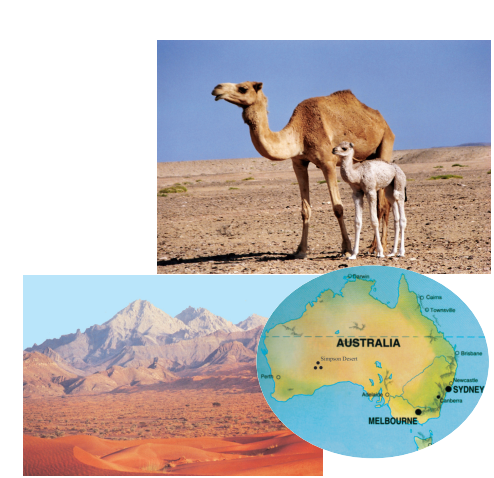Unit 9 lớp 12: Deserts-Reading
Bài học Unit 9 Lớp 12 Deserts phần Reading truyền tải thông tin về sa mạc và cuộc sống thiên nhiên ở đây. Qua đó, luyện tập cho các em đoán nghĩa theo ngữ cảnh và gợi ý để làm bài tập chọn đúng hay sai.
Mục lục nội dung

Work in pairs. Ask and answer the following questions (Làm việc từng đôi. Hỏi và trả lời các câu hỏi sau)
1. What do you know about deserts? (Bạn biết gì về sa mạc?)
2. What kinds of plants and animals live in a desert? (Loại thực vật và động vật nào sống trong sa mạc?)
3. Name some of the countries which have deserts (Kể tên một số nước có sa mạc)
Guide to answer
1. Deserts are the large areas of sand without tree and water, but with severe climates, very hot during the day, and very cold at night. There is very little rainfall there; very few people and animals live except for in oases. (Sa mạc là những vùng đất cát rộng lớn không có cây cối và nước, nhưng với khí hậu khắc nghiệt, rất nóng vào ban ngày, và rất lạnh vào ban đêm. Ở đó có rất ít mưa ; rất ít người và động vật sống ngoại trừ trong các ốc đảo.)
2. In a desert, only cacti and a kind of spinifex can grow. No kind of animals can live in deserts. (Trong sa mạc, chỉ có xương rồng và một loại cây lá kim mới có thể phát triển. Không một loại động vật nào có thể sống trong sa mạc.)
3. Australia, Mongolia, the USA and in north Africa have deserts. (Úc, Mông Cổ, Hoa Kỳ và ở Bắc Phi có sa mạc.)
2. While You Read Unit 9 lớp 12
Read the passage and do the tasks that follow (Đọc đoạn văn làm bài tập kèm theo)
Three great stretches of sandy desert almost circle the centre of Australia. To the north of Nullabor Plain stretches the Great Victoria Desert. In the west, the Gibbon, Great Sandy, and Tanami Deserts comprise an enormous sandy area. North of Lake Eyre lies the Simpson Desert, the last part of Australia to be explored.
The Simpson Desert lies between Lake Eyre in the south, the Macdonnel Ranges in the north, the Mulligan and the Diamantina Rivers in the east, and the Macumba and Finke Rivers in the west. The first European entered the Simpson Desert in 1845. But the desert remained a mystery until Madigan made an aerial survey in 1929. He named the desert after Simpson, President of the South Australian Branch of the Royal Geographical Society of Australia.
In 1936, Colson and an Australian Aborigine took camels across the desert. They travelled along the border of South Australia and the Northern Territory. Three years later Madigan led a scientific expedition across the sand dunes on a more northerly route. Colson and Madigan both travelled eastward across the Simpson Desert.
In the Simpson Desert there are different types of dunes. In the western part of the desert, there is a network of short dunes, mostly less than 10 metres high. Hummock grasses grow in loose sand on the crest and spinifex grows in the corridors between dunes and on the more stable slopes.
In the northern part of the desert, the dunes are parallel and separated by corridors of low, open shrubland. Spinifex grows on the slopes of the dunes. These dunes are deep red-brown, but the sand is pale in the area where Queensland, South Australia and Northern Territory meet. Dry salt lakes up to 70 kilometres long and 15 kilometres wide lie between long dunes with crests 20 metres high.
Tạm dịch
Ba dải đât rộng lớn của sa mạc cát hầu như bao quanh phần trung tâm của nước Úc. Về phía bắc của bình nguyên Nullabor trải dài Đại Sa mạc Victoria. Về phía tây, sa mạc Gibbon, Great Sandy và sa mạc Tanami bao gồm một khu vực cát mênh mông. Phía bắc cùa hồ Eyre trải dài sa mạc Simpson, phần cuối cùng của nước Úc được khám phá.
Sa mạc Simpson nằm giữa Hồ Eyre ở phía nam, dãy Macdonnel ở phía bắc, hai dòng sông Mulligan và Diamantina ở phía đông, hai sông Macumba và Finke ở phía tây. Những người Âu châu vào sa mạc Simpson năm 1845, nhưng sa mạc vẫn là nơi bí hiểm cho đến khi Madigan thực hiện cuộc khảo sát trên không vào năm 1929. Ông đặt tên cho sa mạc là Simpson, tên của Chù tịch Chi nhánh phía nam của Hội Địa lí Hoàng gia Úc.
Năm 1936, Colson và một thổ dân úc dùng lạc đà băng qua sa mạc. Họ đi dọc theo ranh giới Nam úc và Northern Territory. Ba năm sau, Madigan dẫn một đoàn thám hiểm băng qua những đồi cát theo đường tiến xa về phía bắc hơn. Cả hai Colson và Madigan đi về phía đông băng qua sa mạc Simpson.
Ở sa mạc Simpson có nhiều loại hình đồi cát khác nhau. Ở phía tây của sa mạc, có một mạng lưới đồi cát thấp, phần lớn cao không tới 10 mét. Cỏ đồi cát mọc trên cát xốp trên đỉnh và cây lá nhọn mọc ở phần đất giữa những đồi cát và trên những triền dốc ổn định hơn.
Về phía bắc của sa mạc, những đồi cát chạy song song và được phân cách bởi những đường hành lang của những vùng đất có cây bụi trống và thấp. Cây lá nhọn mọc trên triền dốc của đồi cát. Những đồi cát này màu nâu đỏ sẫm, nhưng cát màu lợt ở những khu vực Queensland, Nam úc và Northern Territory gíao nhau. Những hồ muối khô dài đến 70 cây số, rộng 15 cây số nằm giữa những đồi cát dài với đỉnh cao 20 mét.
2.1. Task 1 Unit 9 lớp 12
Give the Vietnamese equivalents to the following words or phrases (Cho nghĩa tiếng Việt tương đương cho những từ hay cụm từ sau)
1. stretch ____________
2. sandy ____________
3. aerial survey ____________
4. Royal Geograhical Society of Australia ____________
5. Australian Aborigine ____________
6. dune (n) ____________
7. sloping ____________
8. steep ____________
9. hummock ____________
10. crest ____________
11. pinifex ____________
Guide to answer
1. trải dài
2. có cát
3. cuộc khảo sát trên không
4. Hội Địa lí Hoàng gia Úc
5. thổ dân Úc, dân bản xứ Úc
6. đồi cát
7. dốc thoai thoải
8. dốc đứng
9. gò, đống
10. đỉnh
11. cỏ lá nhọn ( ở sa mạc Úc)
2.2. Task 2 Unit 9 lớp 12
Decide whether the statements are true (T) or false (F) (Quyết định xem những câu sau đúng (T) hay sai (F))
T F
.png)
.png) 1. According to the passage, there are three great deserts in Australia.
1. According to the passage, there are three great deserts in Australia.
.png)
.png) 2. The Simpson Desert is the largest one in Australia.
2. The Simpson Desert is the largest one in Australia.
.png)
.png) 3. The desert was named after Simpson in 1929.
3. The desert was named after Simpson in 1929.
.png)
.png) 4. Colson and Madigan travelled across the Simpson Desert in 1936.
4. Colson and Madigan travelled across the Simpson Desert in 1936.
.png)
.png) 5. There are more dunes in the western part of the desert.
5. There are more dunes in the western part of the desert.
.png)
.png) 6. Dry salt lakes are in the northern part of the desert.
6. Dry salt lakes are in the northern part of the desert.
Guide to answer
1. False
2. False
3. True
4. False
5. False
6. True
2.3. Task 3 Unit 9 lớp 12
Answer the following questions (Trả lời các câu hỏi sau)
1. What are the names of the three great stretches of sandy desert which circle the centre of Australia?
2. Where is the Simpson Desert?
3. When did the first European enter the desert?
4. Who was Simpson?
5. How did E. A. Colson and an Australian Aborigine travel across the desert?
6. What are the dunes like in the western and northern parts of the desert?
7. How many kinds of grass grow in the Simpson Desert? What are they?
Guide to answer
1. They are Great Victoria, Gibbon, Great Sandy, Tanami Deserts and Simpson Desert.
2. It lies between Late Eyre in the south, the Macdonnel Ranges in the north, the Mulligan and the Diamantia Rivers in the east, and the Macumba and Finke Rivers in the west.
3. In 1845.
4. He was the President of the South Australian Branch of the Royal Geographical Society of Australia.
5. They took camels across the desert.
6. In the western part, they are short, mostly less than 10 meters high, and in the northern part, they are paralell and up to 20 meters high.
7. Two. They are hummock grasses and spinifex.
3. After You Read Unit 9 lớp 12
Read this story and answer the questions that follow (Đọc câu chuyện này và trả lời câu hỏi kèm theo)
At a restaurant, a Vietnamese interpreter was having dinner with an American businessman. It was a delicious dinner and both of them enjoyed it enormously. Before the dinner was over, the interpreter asked the American businessman: “What would you like for your desert?” After a pause, the American businessman answered: “Trees and water”.
1. Is the story funny? (Câu chuyện có vui không?)
2. Where is the fun? (Nó vui ở chỗ nào?)
Guide to answer
1. Yes, it really is. (Có)
2. It’s the interpreter's pronunciation. He pronounced the word “dessert" wrongly, which made the American businesman misunderstand him. That's really a great pity or shame.
Ở một nhà hàng, một thông dịch viên người Việt đang dùng cơm tối với một thương gia Mĩ. Bữa ăn tối ngon và cả hai rất thích thú. Trước khi bữa ăn kết thúc, người thông dịch hỏi thương gia Mĩ, "ông muốn gì cho sa mạc của ông?” Sau khi suy nghĩ một tí, thương gia Mĩ trả lời. "Cây và nước.” (Đó là phát âm của người phiên dịch. Anh ấy phát âm từ "dessert" sai, làm cho doanh nhân Mỹ hiểu nhầm ý anh ấy. Thật là xấu hổ.)
4. Practice Task 1
Read the passage carefully and choose the correct answer (Đọc đoạn văn và chọn câu trả lời đúng)
A desert is a hostile, potentially deadly environment for unprepared humans. In hot deserts, high temperatures cause rapid loss of water due to sweating, and the absence of water sources with which to replenish it can result in dehydration and death within a few days. In addition, unprotected humans are also at risk from heatstroke.
Humans may also have to adapt to sandstorms in some deserts, not just in their adverse effects on respiratory systems and eyes, but also in their potentially harmful effects on equipment such as filters, vehicles and communication equipment. Sandstorms can last for hours, sometimes even days.
Despite this, some cultures have made hot deserts 'their home for thousands of years, including the Bedouin, Tuareg tribe, and Pueblo people. Modern technology, including advanced irrigation systems, desalinization and air conditioning, has made deserts much more hospitable, In the United States and Israel for example, desert farming has found extensive use.
In cold deserts, hypothermia and frostbite are the chief hazards, as well as dehydration in the absence of a source of heat to melt ice for drinking. Falling through pack-ice or surface ice layers into freezing water is a particular danger requiring emergency action to prevent rapid hypothermia. Starvation is also a hazard; in low temperatures the body requires much more food energy to maintain body heat and to move. As with hot deserts, some people such as the Inuit have adapted to the harsh conditions of cold deserts.
1. The text is about ________.
a. troubles that human beings have to face in a desert
b. desert storms and desert inhabitants
c. hot deserts and cold deserts in the United States
d. desert hospitality and environment
2. Which is not a problem for an unprepared man in a hot desert?
a. sandstorm b. loss of water c. irrigation d. heatstroke
3. Sandstorms ________.
a. do no harm to machinery
b. have effects only on the eyes
c. never lasts more than one hour
d. have bad effects on both human beings and machinery
4. Which sentence is true?
a. No one can survive in both hot and cold deserts.
b. Modern technology makes deserts more hospitable.
c. In the United States, all deserts are quite uninhabited.
d. There are no deserts in Israel.
5. Which is not a problem in cold deserts?
a. Starvation b. Hypothermia c. Frostbite d. Body heat
5. Practice Task 2
Fill in each numbered blank with one suitable word or phrase (Điền vào các chỗ trống sau từ hay cụm từ phù hợp)
Most traditional human life in deserts is nomadic. It (1) ______ in hot deserts on finding water, and on following infrequent rains to (2) ______ grazing for livestock. In cold deserts, it depends on finding good hunting and fishing grounds, on sheltering from blizzards and winter (3) ______, and on storing enough food for winter. Permanent settlement in both kinds of deserts requires permanent water, food sources and adequate shelter, or the technology and energy sources to (4) ______ it.
Many deserts are flat and featureless, lacking landmarks, or composed of repeating landforms such as sand (5) ______ or the jumbled ice-fields of glaciers. Advanced skills or devices are required to navigate through such landscapes and (6) _____ travelers may die when supplies run (7) ______ after becoming lost. In addition, sandstorms or blizzards may cause disorientation in severely-reduced visibility.
The (8) ______ represented by wild animals in deserts has featured in explorers' accounts but does not cause higher (9) ______ of death than in other environments such as rainforests or savanna woodland, and generally does not affect human distribution. Defense against polar bears may be advisable in some areas of the Arctic. Precautions against snakes and scorpions in choosing (10) ______ at which to camp in some hot deserts should be taken.
1. a. locates b. selects c. follows d. depends
2. a. earn b. demand c. obtain d. require
3. a. extremes b. poles c. tops d. heights
4. a. grow b. supply c. comfort d. bring
5. a. dunes b. piles c. valleys d. stores
6. a. inconsistent b. incapable c. inexperienced d. independent
7. a. of b. out c. in d. over
8. a. danger b. dangerous c. endanger d. endangered
9. a. level b. rate c. scale d. standard
10. a. sight b. lies c. sites d. seats
6. Conclusion
Qua bài học này các em cần ghi nhớ một số từ vựng quan trọng sau
- acacia [ə'kei∫ə] (n): cây keo
- aerial ['eəriəl] (adj): trên trời, trên không
- antelope (n): nai sừng tấm
- cactus (n): cây xương rồng
- camel (n): lạc đà
- colony ['kɔləni] (n): thuộc địa, bầy, đàn
- crest [krest] (n): đỉnh, ngọn
- dune [dju:n] (n): cồn cát,đụn cát
- expedition [,ekspi'di∫n] (n): cuộc thám hiểm, thăm dò
- gazelle [gə'zel] (n): linh dương
- hummock ['hʌmək] (n): gò đống
- jackal (n): chó hoang sa mạc
- slope [sloup] (n): dốc,độ dốc
- spinifex (n): cỏ lá nhọn (úc)
- stretch [stret∫] (v): kéo dài,căng ra
- tableland (n): vùng cao nguyên
- branch (n): nhánh (sông), ngả (đường), cành cây
- lead [li:d] (v): chỉ huy, dẫn đường
- route [ru:t] (n): tuyến đường; lộ trình, đường đi
- corridor ['kɔridɔ:] (n): hành lang
- parallel (adj): song song, tương tự
- eastward ['i:stwəd] (adj) (n): hướng đông
- loose (adj): lỏng,mềm (v): thả lỏng
- wide [waid] (a): rộng
- survey ['sə:vei] (v): quan sát, sự điều tra
- aborigine [,ỉbə'ridʒini:z] (n): thổ dân,thổ sản
- steep (n); (adj): dốc; (v): ngập vào nước
- enormous [i'nɔ:məs] (a): to lớn,khổng lồ

